Are you the proud owner or future purchaser of a battery electric vehicle (BEV) or a plug-in hybrid electric vehicle (PHEV)? Don’t forget the charger. You’ll use public charging stations when you’re on a road trip, but the experience of owning an electric vehicle (EV) improves dramatically when you can recharge on your own schedule, without having to worry about finding a place to plug in moving your car when it’s done charging. A personal charger also lets you take advantage of the best electric rates, especially if your utility charges lower rates in off-peak hours.
Most EVs include a cable that allows you to plug into a standard household outlet for what’s known as Level 1 charging. In the U.S., that means a 120V circuit capable of adding about 3-5 miles of range for every hour of charge. This sort of trickle charging might be good enough to cover your daily commute if you charge overnight, but it gets frustrating fast.
A much better choice is a Level 2 charger, which requires a 240V circuit. Depending on your car’s capabilities and the Level 2 charger’s output current, you can add 30-60 miles of range for every hour of charging. A Level 2 charger doesn’t have to be expensive, and the hardest part of installation typically involves paying an electrician to wire a 240V circuit for it.
The most important feature to look for in a Level 2 charger is compatibility with the charging capabilities of your vehicle. That includes not just the plug at the end of the charging cable but also the amount of power your EV is capable of accepting. Many PHEVs, for example, charge at a very low power rate, so spending extra for a high-powered charger is wasting money.
All of the chargers we selected for this guide are designed for the U.S. market and are suitable for installation in a home that has a 240V circuit available. Each one includes a J1772 connector that is compatible with all current EVs (Tesla models use an adapter).
ChargePoint Home Flex EV charger
A clean, easy-to-use option from a familiar brand
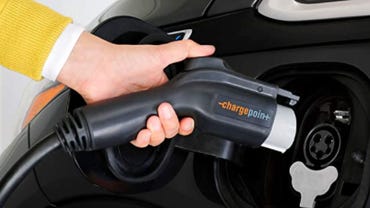
If the ChargePoint name sounds familiar, that’s not surprising. ChargePoint manages a nationwide network of publicly available charging stations (free and paid) that are readily accessible through the company’s easy-to-use app, and it’s planning to spend a billion dollars over the next decade adding charging stations across the U.S. So, it’s no surprise that the company has leveraged that name recognition into a home charging product.
The HomeFlex charger is available in two configurations for use with NEMA 6-50 or NEMA 14-50 plugs and can be set to use a charging amperage from 16 amps to 50 amps, depending on your home circuit’s capabilities. The 23-foot cable should be long enough for most home installations.
The ChargePoint app allows you to keep track of all your charging sessions, at home and on the road. For home use, you can set schedules to charge when rates are cheapest. The app is compatible with Alexa voice control.
Juicebox 40
Sleek charging with built-in cable management
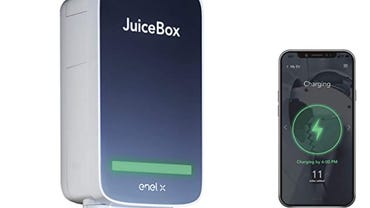
The JuiceBox line of home chargers, designed and built by the global energy company Enel X, come in three sizes. The midrange JuiceBox 40 is the most versatile and most popular and can plug into any standard 240V circuit or can be hardwired. All three models can be configured to safely charge multiple vehicles simultaneously on a single circuit.
The hardware package is handsome and built to handle indoor or outdoor installations in challenging climates. It also rates high on usability, with a 25-foot cable that works well even in locations where an existing 240V circuit is inconveniently located. A built-in rack tidies up cable storage, and a locking mount secures the installation.
The JuiceBox mobile app works with Amazon Alexa and Google Assistant and supports smart charging based on the lowest rates for your utility.
Blink HQ 150
Not the most powerful charger around, but significantly cheaper than many rivals
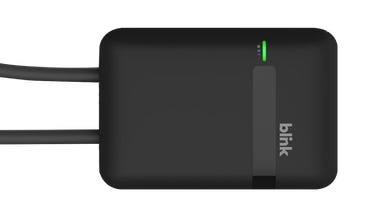
At 32 amps, this charger should hit the “good enough” standard for most EV owners, with a lower price tag sealing the deal. That lower output might be a dealbreaker if you’re counting on getting a quick charge in an hour or two, but the difference compared to a 40 or 50 amp charger isn’t noticeable if you routinely charge overnight.
The no-nonsense hardware package is designed to be plugged into a standard 240V outlet, and the 25-foot cable should reach comfortably from the garage to the driveway. Blink also has a public charging network that includes a few perks for owners of home chargers. The Blink app is primarily geared toward that network but still offers most of the options you need for flexible home charging.
Grizzl-E Classic
This Canadian alternative offers a budget price tag without skimping on features
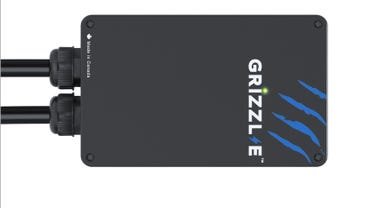
There’s a big maple leaf and a “Made in Canada” label on the front of this utilitarian black box (a white alternative is available if your design sense demands). That branding, along with the bright blue streaks that look like a bear’s claw marks, says a lot about the company behind this no-frills charger.
You’ll need a 40 amp circuit to take advantage of its full power, although you can also configure it for lower charge rates. There’s no Wi-Fi connection, and you’ll pay extra for an outdoor safety lock. It does, however, offer the option of a dedicated Tesla plug instead of the standard J1772. And if you’re a two-EV household, consider the Grizzl-E Duo, which has two 24-foot cables for simultaneous charging.
Electrify HomeStation
Electrify America adds to its nationwide network with a home option
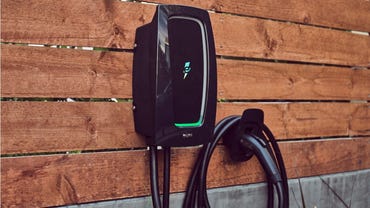
The Electrify America network, which was born out of the settlement from Volkswagen’s diesel emissions scandal, has a huge and rapidly expanding network of charging stations across the United States. Like its rival ChargePoint, the company has expanded into home markets.
From the mobile app, you can manage local charging sessions, set reminders, and schedule charging for off-peak times. Alexa support is built-in, but Google Assistant support is still listed as “under development.”
The hardware design is simple and sleek, with a glossy black finish accented by green LED lighting. The 24-foot cable should meet most needs, and the operating temperature is rated from a bone-chilling -22F to a scorching 122F. Unless you live in International Falls or Death Valley, those parameters should work.
Which charging solution is appropriate if I live in a condo?
Charging your EV is more complicated if you don’t have a private garage or other secure space to install your charger. The complications increase exponentially if you live in an apartment building or condo with shared parking areas and no way to access your personal electric meter. For those situations, your best bet is to petition your apartment management or condo HOA to install shared chargers that can be billed using an app. ChargePoint has some good options and even has sample letters you can send to your skeptical managers or condo board to speed the process along.
What is the best home EV charger?
Our top picks include: ChargePoint Home Flex EV charger and Electrify America HomeStation.
Are there any tax breaks for EV owners who buy a personal charger?
Many EV purchases in the U.S. qualify for a Federal tax credit of as much as $7,500. (Sorry, Tesla and GM owners, you don’t qualify.) But home chargers also qualify for some healthy tax breaks. The Federal tax credit of up to 30% of the charger’s cost, up to a maximum of $1000, expired at the end of 2021 but is likely to be extended for 2022 (a bill doing so has already passed the U.S. House of Representatives). In addition, your state and your power company might offer additional credits. To check your possible savings, try this interactive incentive checker.
What size charger do I need?
There’s no one-size-fits-all answer to that question. Your home’s electrical wiring dictates how powerful a circuit you can make available for EV charging, and your car itself has a limit on how much power it can accept. Before you buy a charger, it makes sense to talk to a local electrician who can evaluate your existing circuitry, match it with your EV, and recommend what specs to look for.
Are there alternative home EV chargers worth considering?
Here are a few options to also check out:




















